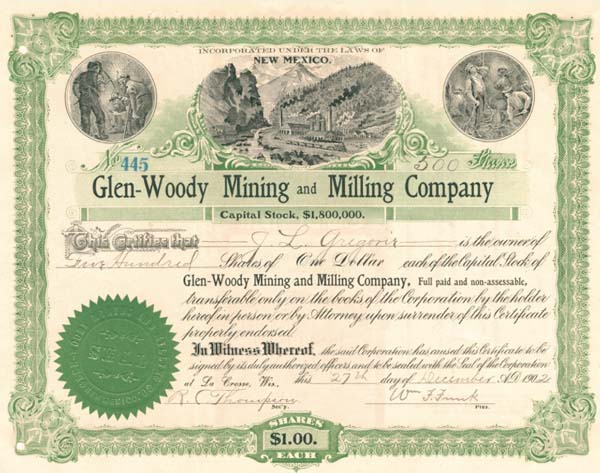Glen-Woody Mining and Milling Co. - Stock Certificate
Inv# MS1233 Stock
State(s):
New Mexico
Years:
1902-03
Rare State!
CieneguiUa (Glen-Woody) District-
Nowhere in the southwest is such an enormous body of
quartz and quartzite to be seen as at the Glen- Woody camp
in the CieneguiUa mining district.
This camp was established in the summer of 11102, by
W. M. Wood3% who represents the Glen -Woody Mining and
Milling Company.
Mr. Woody, before going to Alaska at the time of the Klon-
dike gold discovery, operated placer mines on the Rio
Grande, one half mile below^ the present camp; this was the
time when his attention w^as first drawn to the immense
body of quartzite.
These placers were in the gravel bed of the river; but w^ere
not successful financially, owing to interference of mal pats
boulders lying in the bed of the stream. It was at this time
that attention was attracted by the enormous quartz deposits
w4iich w^ere exposed along the stream.
Glen-Woody camp is w^here latitude 36-^ 20' North, crosses
the Rio Grande, in Taos county. The townsite is on the
west side of the river, while the mill and ore body is on the
opposite or east side.
The bridge at this point was built on some of the old piers
NEW MEXICO MINES AND MINERALS. 159
of a government bridge which was burned by the Apache
Indians during their hostilities in the latter seventies; the
bridge was never rebuilt by the government.
An experimental plant of 50 tons capacity, consisting of a
a 5-foot Huntington mill, with cyanide tanks has recently
been completed.
The machinery is run by water power; the water being
conducted by a flume out of the river about one mile above
the mill. The power is developed by a 160 H. P. turbine
wheel. This power is ample to run several more Hunting-
ton's should the experimental runs be a success.
The Glen-Woody ore may, generally speaking, be classed
as quartzite; although stringers and veins of quartz run
through the deposit at numerous places. These quartz veins
and stringers sometimes attain a width of several feet. The
width of the main lode itself is approximately 600 feet; and
rises to an average height above the river of 300 feet. The
Company has three full claims, making 4,500 feet along the
lode. Approximately, there are 50,000,000 tons of ore above
the river which may be considered in sight. The length of
this enormous lode cannot well be ascertained, since it
crosses the river about half a mile below the bridge where it
is covered by the mesa lava, and in following up stream the
river deflects to the left gradually leaving the lode more than
a thousand feet at the easterly end of the Glen-Woody prop-
erty.
It is quite probable that the lode is four miles long; the
northeasterly end disappearing under detritus at the top of
the hill.
From a survey made by the writer of the property in No-
vember, 1903, the strike of the lode was found to be N. 60^
22' E. and the dip about 80^ to the southeast.
A much sheared quartzite lies on the foot wall next to the
river, and a similar quartzite is on the hanging wall though of
a lighter color. The exact age of this formation has not been
determined; though it probably is Cambrian.
The general appearance of the main lode is of a reddish
tint; although some of the best grade of ore is a granular
white quartz. The only question concerning this property
as a merited mining proposition, so far as the writer is able
«5
^ ^ ^: "X" Xx ^-^ V- vX \/ ^
'f^ «snwrRead More
A stock certificate is issued by businesses, usually companies. A stock is part of the permanent finance of a business. Normally, they are never repaid, and the investor can recover his/her money only by selling to another investor. Most stocks, or also called shares, earn dividends, at the business's discretion, depending on how well it has traded. A stockholder or shareholder is a part-owner of the business that issued the stock certificates.
Item ordered may not be exact piece shown. All original and authentic.










Ebay ID: labarre_galleries